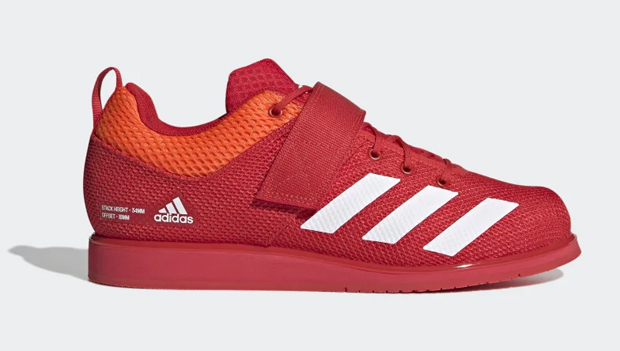
While lifting heavy objects is probably as prehistoric as our paleo ancestors, rumor has it that proper deadlifting form came from Roman generals who realized that their soldiers were getting injured lifting corpses into the grave.
Well—we lift iron now, but our form hasn't changed all that much. What has changed is the introduction of footwear specifically for this feat of strength. That's right: deadlifting shoes. Whether it was the fear of germs or the slippery floor of a gym that inspired the first lifter to don a pair of shoes, we're glad they did: Not only do they provide benefits, but they also look badass.
While many diehards opt to lift barefoot in the way of the ancients, the best deadlifting shoes provide a close-to-the-ground foot feel, while lending traction and more or less support, depending on your needs. And, let's face it—your gym probably requires them. Unless it's your home gym, in which case you better be sure to install a platform and make sure you have the best deadlift bar and perfect deadlift form.
So without further ado, we bring you the best shoes for deadlifting. We chose several standouts in certain categories for the casual lifter up to the most committed and competitive. We also include a guide and answer common questions so you know what to look for in your ultimate pair.
Why Trust Us?
ACTIVE.com's editorial team relies on the knowledge and experience of fitness and wellness experts including competitive athletes, coaches, physical therapists, nutritionists, and certified trainers. This helps us ensure the products we feature are of the highest standard. Collectively, the team has spent countless hours researching equipment, gear, and recovery tools in order to create the most accurate, authentic content for our readers. Customer satisfaction is also a key part of our review process, which is why we only feature products that are highly rated.
The Best Shoes for Deadlifting - Our Top Picks
By clicking on the product links in this article, we may receive a commission fee at no cost to you, the reader. Sponsorships and affiliate commissions help support our research so we can help you find the best products. Read the full affiliate disclosure here.
- Best Overall Shoes for Deadlifting: adidas - The Total Shoes
- Best Budget Shoes for Deadlifting: Converse Chuck Taylor All Star Sneakers
- Most Comfortable Shoes for Deadlifting: Vans Sk8-Hi Shoe
- Best Deadlifting Shoe for Wide Feet: Reebok Nano X1 Cross Trainer
- Best Deadlifting Shoes for Heavy Lifters: Nobull Trainers
- Best Deadlift Shoes for Powerlifters: adidas Powerlift 5 Weightlifting Shoes
Best Overall Shoes for Deadlifting - adidas The Total Shoes
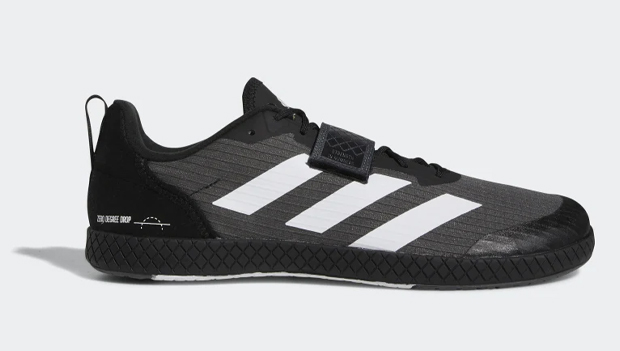
SPECS
- Weight: 12.1 oz.
- Best for: Lifters looking for a pair that lasts
Deadlift shoes in the style of adidas—what's not to like? The zero heel drop is essential for efficient lifts using traditional form. The rubber outsole and reinforced toe provide traction, protection, and durability. The added strap will help lock your foot in for that snug and secure feeling that goes a notch beyond the casual lifting shoe. Their wide toe box isn't just ideal for wide feet, getting as much toe splay as possible will help you stabilize for the best lifts. Plus, the upper is made of at least 50 percent recycled materials, which is a step in the right direction for the environmentally conscious.
No, they're not as cheap as Vans or Chuck Taylors, but they'll likely last longer and they could still pass as street shoes on your way to the gym. Deadlift purists seeking the thinnest possible outsole may want to look elsewhere.
What We Like
- Zero drop
- Wide toe box
- Comfortable textile upper
- Strap for extra snug closure
- Recycled materials
What We Don't Like
- A little pricey for some
- Could be lower to the ground
Best Budget Shoes for Deadlifting - Converse Chuck Taylor All Star
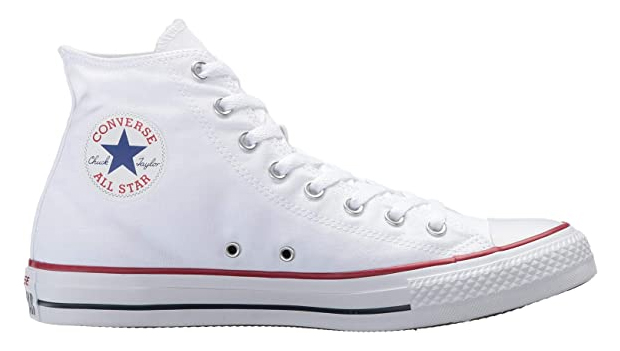
SPECS
- Weight: 14.3 oz.
- Best for: Lifters seeking a no-brainer option in and out of the gym
When Converse first released its Chuck Taylors in 1922 they couldn't have predicted their longevity as iconic street shoes. But even fashionistas don't know their cult status among deadlifters who are drawn to their relatively thin zero drop outsoles with superior traction, breathable canvas uppers, and mild ankle support. All of this, plus their low price and timeless style in or out of the gym, make the Chuck Taylors one of the best—and most unlikely—deadlifting shoes.
While they do offer ankle support, it's not at the level a podiatrist might recommend, especially when recovering from an existing ankle injury. They do offer wide sizes now, but some may find them too narrow in the midfoot while others find this keeps them snug. The canvas may be thin and breathable but it gets sweaty and will likely tear eventually. And in some models, the soles are glued in so good luck trying to replace them. This results in a stinky shoe over time. But you can throw them in the wash or soak and wash them by hand.
What We Like
- Breathable, thin canvas uppers
- Zero drop and relatively thin outsole
- Timeless style in and out of the gym
- Mild ankle support
- Very affordable
What We Don't Like
- Can get sweaty and stinky
- No strap for extra snug fits
- Not as durable as other options
BUY: Converse Chuck Taylor All Star
Most Comfortable Shoes for Deadlifting - Vans Sk8-Hi Shoe
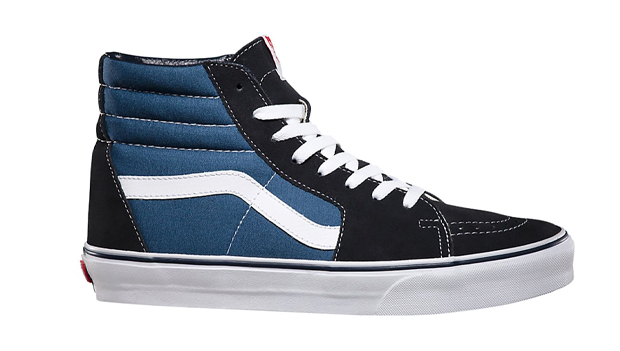
SPECS
- Weight: 17.5 oz.
- Best for: Casual training
It's funny to think that a pair of Vans ever made it into a gym. Beloved by skaters everywhere for their thin sole, traction, and foot feel, it turns out these same qualities benefit deadlifters, too. Their suede and canvas upper may not be an athletic material but it's soft and flexible.
The midsole foam strikes a balance between cushioning and power transfer, making it a good everyday training shoe. You probably won't wear these on competition day, but you'll wish you could since they come in so many funky styles. They are super affordable, but that does come at a price as they're not the most durable shoes. The outsole inevitably tears at stress points and then eventually detaches from the upper.
What We Like
- Great traction
- A bit of cushion for comfort
- Ultra affordable
What We Don't Like
- The uppers will get hot, sweaty, and smelly
- Can run narrow
- The outsole tends to tear at stress points and detach from the upper
BUY: Vans Sk8-Hi Shoe
Best Deadlifting Shoes for Wide Feet - Reebok Nano X1 Cross Trainer
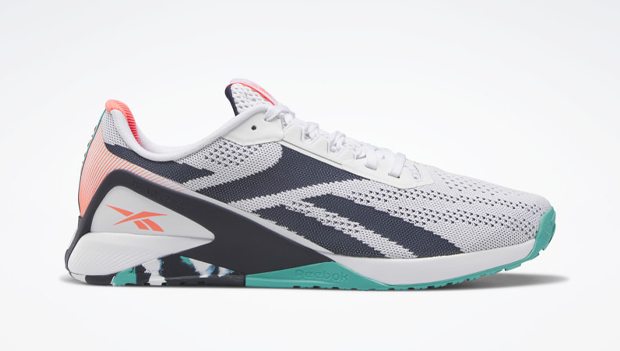
SPECS
- Weight: 12.1 oz.
- Best for: The CrossFit enthusiast who only deadlifts casually
While they're not deadlifting shoes, per se, we thought we would include a pair of cross-training shoes for those who deadlift more casually mid-circuit. The knit upper is pretty breathable but it also has some structural elements that show it's built to last. The heel clip adds ankle stability for lateral movements and generally toughens up the shoe. Yes, the cushion won't please deadlift diehards, but for the lightweights out there, it might feel just right. Just don't try to be a hero and hit your PR—you'll just have to use the non-traditional snatch technique. And if you're more serious about climbing, jumping, yanking, and throwing, these will handle it all with ease.
What We Like
- Great for cross-training
- Breathable yet durable
- Supports lateral movement
What We Don't Like
- Not a proper deadlifting shoe
- Too much cushioning for some
BUY: Reebok Nano X1 Cross Trainer
Best Shoes for Heavy Lifters - NOBULL Trainers
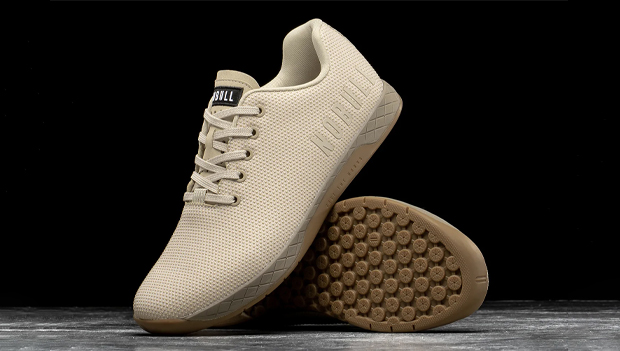
SPECS
- Weight: 10 oz.
- Best for: Heavy lifters seeking shoes light enough for cross-training
When NOBULL first launched in 2015, it polarized the CrossFit community. Many thought they were overhyped and overpriced. Others swore by their versatility and minimal aesthetic. Ultimately, you'll have to try them yourself to see what camp you're in. But here are the facts.
They sport a 4mm drop—not zero but very close. And they're among the lightest of shoes you could actually lift in. Their simple look is up to preference. But all of these factors help make these some of the most versatile shoes that also seriously lift iron. That being said, diehard deadlifters will likely seek more stability in the forefoot. But unlike CrossFit shoes, NOBULLs feature little cushion—a plus for quality foot feel, balance, and power.
Yes, they are quite pricey. But unlike, say, Chuck Taylors, the breathable and flexible uppers won't wear out nearly as fast and won't get as sweaty and smelly either. In their words, "The SuperFabric® creates a 360-degree shield from zombies, rope climbs, and excuses."
What We Like
- Versatile without compromising deadlift features
- Lightweight enough for cross-training
- Minimal aesthetic
What We Don't Like
- A bit of toe rock due to the 4mm drop
- Expensive
BUY: NOBULL Trainers
Best Deadlifting Shoes for Powerlifting - adidas Powerlift 5
SPECS
- Weight: 15 oz.
- Best for: Powerlifting circuits instead of pure deadlifting
If you're into powerlifting, as opposed to pure deadlifting, and you want to avoid the downtime of changing shoes, then the adidas Powerlift 5 could be to your liking. Just note that these are weightlifting shoes and not dedicated deadlifting shoes. They have a pretty high drop suitable for supporting low squats. That means you'll have to use a "clean" (or "snatch") technique in your rotation when you get to the deadlift; since your weight is biased forward, you'll have to clear your knees with the bar using different muscle groups.
Overall, the Powerlift 5 is a good shoe for the money. It has just the right amount of cushion that strikes a middle ground for all your lifts, a secure velcro toe strap, and cushioning around the heel that many pure deadlift shoes lack. Just note that they don't come in wide sizes.
What We Like
- Affordable and versatile
- Cushy heel
- Moderate cushion underfoot for all the lifts
What We Don't Like
- Not suitable for pure deadlift form
- Runs a bit narrow
BUY: Adidas Powerlift 5
Deadlifting Shoes vs. Weightlifting Shoes
If you're new to lifting, you may wonder if you can simply find an all-purpose shoe for general weightlifting instead of having to swap shoes for deadlifts.
The simple answer is that you can—if you're keeping it casual—but you'll need to use a non-traditional technique for deadlifts. That's because weightlifting shoes often have a raised heel (or what some call a "drop") which shifts your weight forward a bit, allowing deeper squats. But that requires more range of motion in a deadlift, requiring more work, utilizing different muscle groups, and causing room for error for heavier deadlifts. While a few centimeters doesn't seem like a lot, it adds up when you're stacking the iron. For that reason, deadlifting in weightlifting shoes requires a "clean" or "snatch" style deadlift—still great for building strength but not optimal for hitting a PR.
Weightlifting shoes tend to have more cushion, too, which makes them versatile around the gym (and to and from, for that matter), but not optimal for transferring your leg power into the ground.
Ultimately, if deadlifting is merely a small aspect of your strength-building routine, you can get away with wearing weightlifting shoes.
Benefits of Shoes for Deadlifting
Deadlifting shoes mimic lifting barefoot, only with a bit more comfort, grip, support, and protection from that dirty gym floor. They're usually as low to the ground as possible, creating no added snatch height and giving you direct power transfer from the leg to the floor. And they have little to no heel-to-toe drop, meaning your weight is squarely under your heels rather than biased forward.
Some styles provide ankle support, which can thwart injuries that will sideline you for months. They also provide substantially more grip than bare feet when sweaty, a feature that might just save your back.
And heck, they just look good. With all the styles out there, you can find a pair that speaks to you.
What to Look for in Shoes for Deadlifting
Seek out shoes that are as flat and close to the ground as possible while providing traction (rubber is best). The goal is to mimic barefoot lifting as much as possible for the purest and most efficient form. They should support wide feet if you have them. Regardless, your toes need to flare out for the best balance and force transfer. Some have a flared heel for an even wider base.
It should be a given that they close snugly; some even have an extra strap for that reason. Ankle support is an optional preference but ideal if you've experienced injuries in the past or you want to play it safe. In this case, high tops are your friend.
FAQs About Deadlifting Shoes
Is it better to deadlift with flat shoes?
Yes, you want a shoe that mimics barefoot lifting. That's because you want zero barriers when transferring force from your legs into the ground. You also want your weight squarely under your heel where you are strongest. This reduces the range of motion and room for error, making for the most efficient deadlift. While you can use a different technique for drop shoes (shoes that slope your feet down), it won't help win your next PR if you're serious about deadlifting.
Are deadlift shoes worth it?
If you're serious about snatching iron from the abyss, a dedicated pair of deadlift shoes are worthwhile. They mimic barefoot lifting, only with some added benefits like grip, protection, and sometimes ankle support.
Yes, you may have to switch shoes during a gym session, but most often we've found that training days have a dedicated focus. Some options, like the Converse Chuck All-Stars, have the benefit of looking cool in and out of the gym.
If you're simply looking to be an all-around weightlifter, then you may opt to wear your weightlifting shoes during deadlifts to reduce downtime normally spent changing into another pair of shoes. Just know that you'll have to use a different form, and don't expect to hit your PR.
Why do people deadlift barefoot?
Lifting barefoot allows the most direct contact with the floor and the best technique, resulting in the most efficient deadlift. Since every centimeter matters when loading on the iron, deadlifting barefoot adds no height that an outsole would, minimizing the range of motion required and essentially resulting in less work. And since there's zero drop (no raised heel), your weight sits squarely where it should—over the heel, allowing for the most efficient way to recruit your muscles during the lift.
However, most gyms and competitions require shoes for hygiene reasons (as you can imagine) and sweaty feet can quickly slip out on certain surfaces. For these reasons, the best deadlifting shoes are as minimal as possible while providing traction.
Are NOBULL shoes good for deadlifting?
NOBULL makes a wide range of shoes, from running sneakers to slides. But if you're serious about lifting, they offer two options: a high-drop weightlifting shoe suitable for general weightlifting (the Lifter) and a near-zero drop shoe called the Trainer, which is suitable for any but the most competitive deadlifter.



